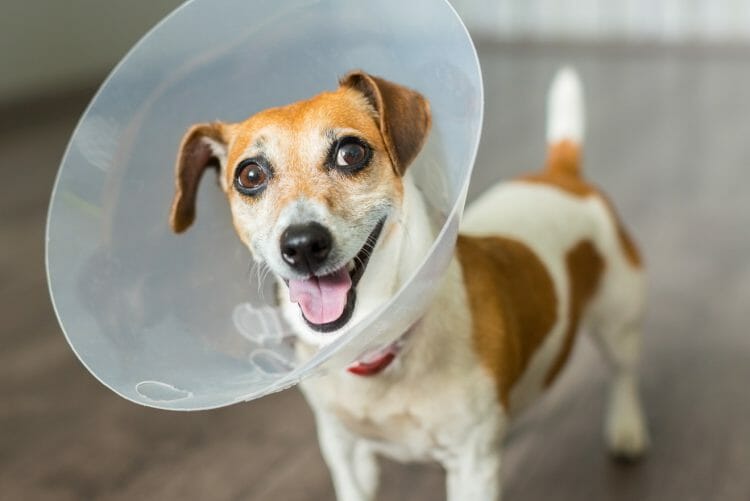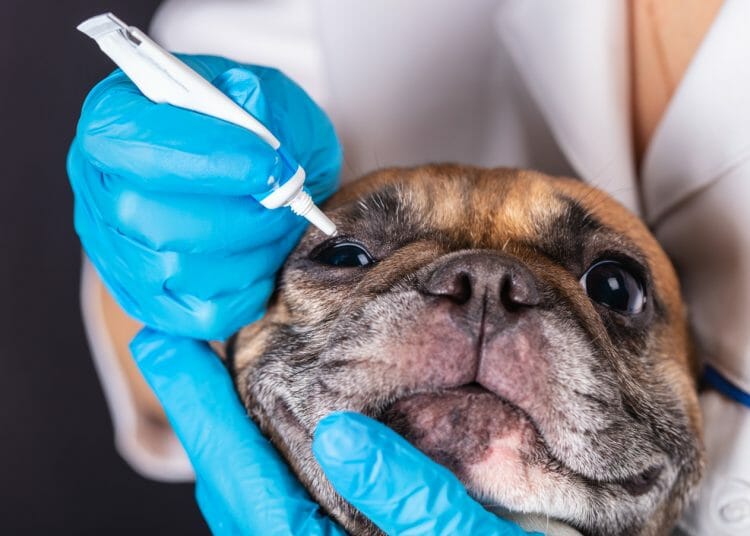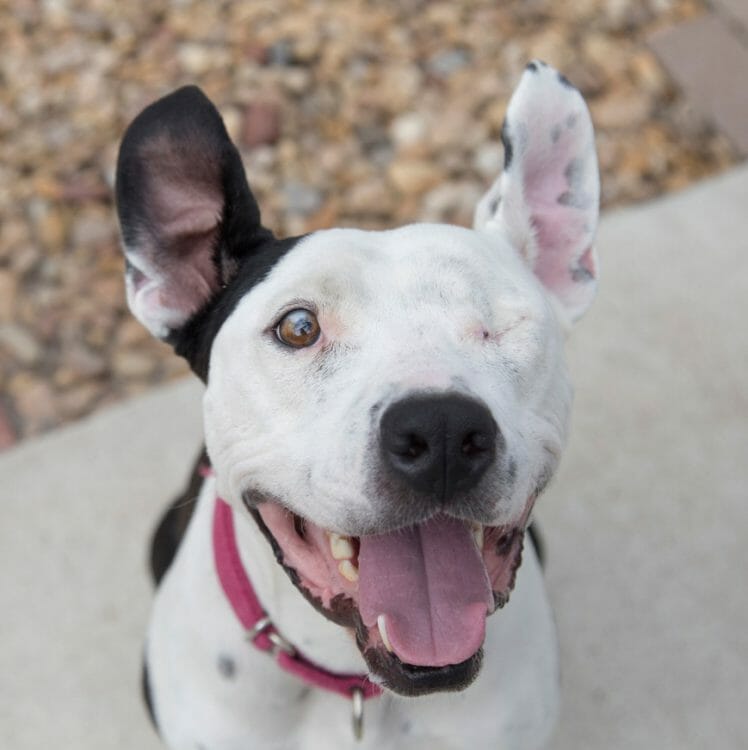What Is a Scratched Cornea in Dogs?
A scratched cornea in a dog can result in blindness depending on the extent of the damage. Often, a shallow scratch on a younger dog will heal and leave no permanent damage. However, a deep scratch could become a corneal ulcer. If this goes deep into the cornea, fluids from inside the eye may leak causing permanent blindness.
A superficial or shallow scratch is one that is less than half the cornea’s depth, whereas one that extends beyond that point is more serious and will require careful monitoring and treatment from a veterinarian.
If a scratched cornea becomes infected, it can also increase the risk of blindness. Swelling caused by infections may prevent healing and could even increase the size and depth of the abrasion.

What Is the Cornea?
The cornea is the clear protective membrane in front of the dog’s eyeball. The cornea is made up of three layers, each with very specific cells.
- Epithelium – the outer layer of cornea made from a thin layer of cells
- Stroma – this consists of supportive tissues
- Descemet’s Membrane – the basement membrane for the endothelial layer
It is not uncommon for a dog’s cornea to get scratched. However, in most cases, the scratches are very minor abrasions and will be barely noticeable. Because all three layers of the cornea are transparent, it is impossible to see any scratches on them without the use of special dye.
What Can Cause A Scratched Cornea in Dogs?
Any sharp or hard object can cause a scratched cornea in dogs. Blades of grass, brambles, and thorns are all common causes of corneal laceration. This type of injury is commonly caused by dogs running through areas of thick undergrowth.
An altercation with another animal may also lead to a scratched cornea. For example, a dog that is swiped by a cat’s claws may end up with a corneal injury.
If a dog has an eyelid mass, it is at a higher risk of corneal abrasion. Although an eyelid mass is often a benign tumor, it could scratch the cornea and leave lasting damage.
Dogs that have entropion (a genetic condition that causes the eyelid to roll inward) may develop scratches on the cornea if the condition is not treated. Abrasions often occur when the dog’s eyelashes scrape against the front of the eye. Dog breeds such as Basset Hounds, Chow Chows, Weimaraners, and Cane Corsos are prone to entropion.
A dog that has protuberant eyes (such as a Pug) often lacks the ability to cover the entire surface of the cornea with its eyelids. This can often leave these types of dog breeds with a higher risk of injury.

Dog Scratched Cornea Symptoms
The signs of a scratched cornea in a dog include:
- Redness in and around the eye
- Swollen tissue around the eye
- Watery eyes
- Keeping one eye closed
- Pawing or rubbing the eye
- A milky appearance on the surface of the eye
The signs and symptoms of a scratched cornea could be confused with keratoconjunctivitis sicca (KCS), a condition that causes inflammation around the cornea. If a dog has KCS, the lacrimal gland will stop producing tears, which means foreign bodies do not get washed away from the surface of the eye.

What to Do If a Dog Has a Suspected Scratched Cornea
If a dog is exhibiting the signs of a scratched cornea and there is a visible scratch on the eye, take the following actions.
- Cover the eye with a clean and damp cloth.
- Bandage the cloth in position and use an Elizabethan collar to prevent the dog from pawing at it.
- Take the dog to a veterinarian immediately.
Diagnosing a Scratched Cornea
A veterinarian will be able to confirm whether a dog has a scratched cornea, as well as the extent of any damage. The vet will use a fluorescein dye, which will cling to the damaged part of the cornea and wash off the rest of the eye.

Treatment for Scratched Cornea in Dogs
If the dog has a superficial scratch that only affects the outer layer of the cornea, treatment will not always be necessary as this type of injury will often heal on its own in less than a week. To help with the healing process, the veterinarian may prescribe eye drops that will help soothe any irritation or discomfort. Even if the scratch is shallow, the veterinarian will usually request that the dog be brought back for a further examination after a few days to check that the scratch is healing as expected.
If the dog has a deep scratch on the cornea, it may require antibiotic drops that will help with any infections and pain during the healing process. Again, the veterinarian will want to examine the dog after a few days to confirm that the treatment is working.
In cases of persistent and deep scratches or ulcers to the cornea that do not respond to medication, surgery may be required to remove the dead layers of the corneal tissue. In these cases, the first intervention is a tissue graft using part of the eye’s lining. This will help provide nourishment to the injury and aid healing.
If the injury becomes an indolent ulcer, a grid keratotomy may be used. This is a minimally invasive surgery that involves both the epithelium and stroma of the cornea. This procedure can be done by a veterinarian under local anesthesia and involves multiple pricks to the stoma. This stimulates healing in the epithelium, allowing it to attach to the stoma.

In instances of severe trauma, it may be necessary to surgically remove the dog’s eye. The veterinarian will often refer the dog to a specialist, such as a veterinary ophthalmologist.
During recovery from a scratched cornea, the dog will usually need to wear an Elizabethan collar. Wearing the cone will prevent the dog from rubbing its eye and reduce the risk of infection. It is important that the dog attends all follow-up visits. Eye problems can deteriorate rapidly without indication. Should the dog’s eye appear to be getting worse between appointments, consult your veterinarian immediately rather than waiting.



